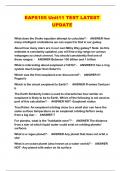Eaps 105 - Study guides, Class notes & Summaries
Looking for the best study guides, study notes and summaries about Eaps 105? On this page you'll find 57 study documents about Eaps 105.
Page 2 out of 57 results
Sort by
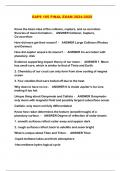
-
EAPS 105 FINAL EXAM 2024-2025
- Exam (elaborations) • 8 pages • 2024
- Available in package deal
-
- $9.99
- + learn more
EAPS 105 FINAL EXAM ...
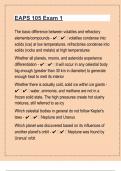
-
EAPS 105|71 Exam 1 Questions With Answers| Success Guaranteed
- Exam (elaborations) • 12 pages • 2024
- Available in package deal
-
- $7.99
- + learn more
The basic difference between volatiles and refractory elements/compounds - ️️volatiles condense into solids (ice) at low temperatures. refractories condense into solids (rocks and metals) at high temperatures Whether all planets, moons, and asteroids experience differentiation - ️️it will occur in any celestial body big enough (greater than 30 km in diameter) to generate enough heat to melt its interior Whether there is actually cold, solid ice within ice giants - ️️water, ammonia,...
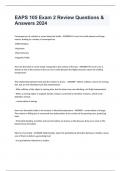
-
EAPS 105 Exam 2 Review Questions & Answers 2024
- Exam (elaborations) • 9 pages • 2024
-
Available in package deal
-
- $8.49
- + learn more
EAPS 105 Exam 2 Review Questions & Answers 2024 Consequences of a planet or moon being hot inside - ANSWER-It is very hot inside planets and large moons, leading to a variety of consequences. -Differentiation -Volcanism -Plate Tectonics -Magnetic Fields How hot the Earth is on the inside compared to the surface of the Sun - ANSWER-The inner core is almost as hot as the surface of the sun, but is solid because the higher pressure raises the melting temperature The relationship bet...
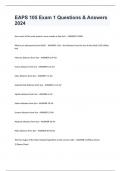
-
EAPS 105 Exam 1 Questions & Answers 2024
- Exam (elaborations) • 7 pages • 2024
-
Available in package deal
-
- $8.49
- + learn more
EAPS 105 Exam 1 Questions & Answers 2024 How much of the solar system's mass resides in the Sun? - ANSWER-99.86% What is an astronomical unit (AU)? - ANSWER-1 AU = the distance from the Sun to the Earth (150 million km) Mercury distance from Sun - ANSWER-0.39 AU Venus distance from Sun - ANSWER-0.72 AU Mars distance from Sun - ANSWER-1.5 AU Asteroid belt distance from Sun - ANSWER-2-3.5 AU Jupiter distance from Sun - ANSWER-5 AU Saturn distance from Sun - ANSWER-10 AU ...
EAPS 105/EAPS105 PACKAGED EXAMS 2024/2025...
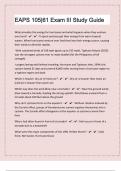
-
EAPS 105|61 Exam III Study Guide With Answers|9 Pages
- Exam (elaborations) • 9 pages • 2024
- Available in package deal
-
- $7.49
- + learn more
What provides the energy for hurricanes and what happens when they venture over land? - ️️Tropical cyclones get their energy from warm tropical waters. When hurricanes venture over land they lose their energy source, causing their winds to diminish rapidly. -With sustained winds of 196 mph (gusts up to 235 mph), Typhoon Haiyan (2013) was the strongest cyclone ever to make landfall (hit the Philippines at full strength) -Longest lasting and farthest traveling: Hurricane and Typhoon John, 19...
BUNDLE - EAPS 105 EXAMS
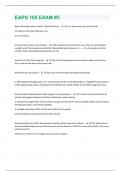
-
EAPS 105 EXAM #3 QUESTIONS AND ANSWERS RATED 100% CORRECT!!
- Exam (elaborations) • 8 pages • 2024
- Available in package deal
-
- $7.99
- + learn more
Basic information about Jupiter's Great Red Spot. - 1.It's about twice the size of Earth 2.It may be more than 350 years old 3.It is shrinking How aerosols influence the climate. - If aerosols like exhaust from cars, ships, and planes block sunlight, won't decreasing such pollution make global warming worse?------> Yes, cleaning up vehicle exhaust could causes global temperatures to rise. How far the Oort Cloud extends. - The Oort Cloud extends out more than a light year from the Su...
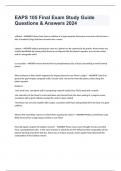
-
EAPS 105 Final Exam Study Guide Questions & Answers 2024
- Exam (elaborations) • 7 pages • 2024
-
Available in package deal
-
- $8.49
- + learn more
EAPS 105 Final Exam Study Guide Questions & Answers 2024 collision - ANSWER-Moons form from a collision of a large impactor that ejects mass into orbit to form a disc of material (ring) that then accretes into a moon capture - ANSWER-objects passing too close to a planet can be captured by its gravity; these moons are readily identifiable by having orbits that are not aligned with the planet's equator, non-circular orbits, and/or retrograde orbits co-accretion - ANSWER-moons formed f...
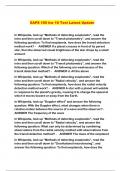
-
EAPS 105 hw 10 Test Latest Update
- Exam (elaborations) • 4 pages • 2024
- Available in package deal
-
- $8.99
- + learn more
EAPS 105 hw 10 Test Latest Update...

Study stress? For sellers on Stuvia, these are actually golden times. KA-CHING! Earn from your study resources too and start uploading now. Discover all about earning on Stuvia

